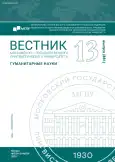The Concepts of “Renaissance” and “Neo-Renaissance”: the Essence, Content, Boundaries of Meanings
- 作者: Normanskaya A.V.1
-
隶属关系:
- Crimean University of Culture, Arts and Tourism, Simferopol
- 期: 编号 13(881) (2023)
- 页面: 150-157
- 栏目: Cultural studies
- URL: https://journal-vniispk.ru/2542-2197/article/view/322655
- ID: 322655
如何引用文章
全文:
详细
The analysis of the concept of “Renaissance” and the experience of its application in cultural and academic practice demonstrates the emphasis on such a semantic aspect as the restoration of the lost status, its re-actualization. This emphasis is due to the original use of the term “Renaissance”, symbolizing the restoration of the values of ancient culture. In the following centuries and today, we can note a situation in which this process is repeated, albeit on a smaller scale; when the very idea of the “revival” of cultural heritage is subjected to “revival”, thereby the boundaries of the meaning of the terms “Renaissance” and “neo-Renaissance” are expanded.
作者简介
Anzhela Normanskaya
Crimean University of Culture, Arts and Tourism, Simferopol
编辑信件的主要联系方式.
Email: anzelanormansky@gmail.com
PhD (Culturology), Associate Professor, Head of the Department of Philosophy, Cultural Studies and Humanities Crimean University of Culture, Arts and Tourism
俄罗斯联邦参考
- Selezneva, E. N. (2013).Theoretical and methodological problems of cultural heritage actualization. Kul’turologicheskij zhurnal, 2, 1–14.
- Pinskij, L. E. (1987). Vozrozhdenie = Renaissance. In Kozhevnikova, V. M., Nikolaeva, P. A. (eds.), Literaturnyj enciklopedicheskij slovar’ (pp. 66–68). Moscow: Sovetskoj enciklopediya. (In Russ.)
- Vazari, Dzh. (1956–1971). Zhizneopisaniya naibolee znamenityh zhivopiscev, vayatelej i zodchih = Biographies of the most famous painters, sculptors and architects: in 5 vols. Moscow: Iskusstvo. (In Russ.)
- Vickers, V. (2002). The idea of the Renaissance, Revisited. Yearbook of the Spanish and Portuguese Society for English Renaissance Studies, 12, 1–27.
- Houghton, L. (2010). Introduction: Veteris vestigia flammae? The ‘Rebirths’ of Antiquity. In Lee, A., Péporté, P., Schnitker, H. (eds.), Renaissance? Perceptions of Continuity and Discontinuity in Europe, c.1300 – c.1550 (pp. 17–26). Leiden&Boston: Brill.
- Baron, N. (1966). The Crisis of the Early Italian Renaissance. 2nd ed. Princeton, 1966.
- Tronskij, I. M. (1946). Istoriya antichnoj literatury. Leningrad: Uchpedgiz.
- Toporova, A. V. (2012). Poema Torkvato Tasso "Osvobozhdennyj Ierusalim": zamysel i ego voploshchenie = Torquato Tasso’s poem “Liberated Jerusalem”: the Idea and its embodiment. In Ezhegodnaya bogoslovskaya konferenciya Pravoslavnogo Svyato-Tihonovskogo gumanitarnogo universiteta = Annual Theological Conference of the Orthodox St. Tikhon’s University for the Humanities (vol. 22-2, pp. 150–153). (In Russ.)
- Babadzhan, S. G. (2022). Neoclassicism in Architecture and Poetry of the 1900s and 1910s: The Commonality of the Problem Field. Actual Problems of Theory and History of Art, 12, 414–425.
- Pavoni, R. (Ed.). (1997). Reviving the Renaissance: The Use and Abuse of the Past in Nineteenth-Century Italian Art and Decoration. Cambridge: Cambridge University Press.
- Vlasov, V. G. (2007). Neorenessans. In Vlasov, V. G. Novyj enciklopedicheskij slovar’ izobrazitel’nogo iskusstva (vol. VI, pp. 188–193): in 10 vols. St. Petersburg: Azbuka-Klassika. (In Russ.)
- Lotman, Yu. M. (2000). Semiosfera i drugie raboty. St. Petersburg: Iskusstvo-SPb. (In Russ.)
- Berseneva, T. P. (2013). Sinergy in culture. Tomsk State University Journal, 377, 36–44. (In Russ.)
- Mazenkova, A. A. (2009). Kul’turnoe nasledie kak samoorganizuyushchayasya sistema = Cultural heritage as a self-organizing system: abstract of PhD. Tyumen’. (In Russ.)
- Normanskaya, A. V. (2020). Texts of gaming as texts of mass culture. Tomsk State University Journal of Cultural Studies and Art History, 37, 37–43. (In Russ.)
补充文件










